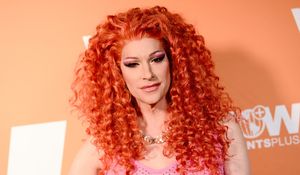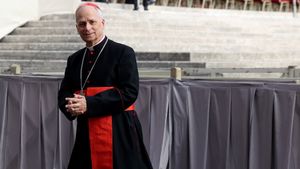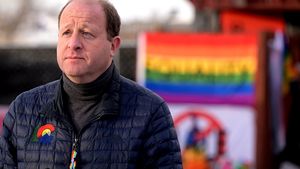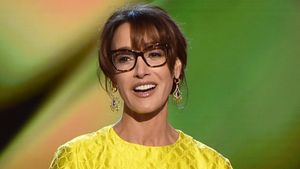Illustration from The Marvels, Scholastic Press. Copyright 2015 Brian Selznick.
How do you write about AIDS for a 10-year-old reader? In Brian Selznick's The Marvels, you simply put the fact out there and let it sit quietly within the pages of the story, synthesized within a larger tale. "I knew very early on that queerness was going to be a part of the landscape of The Marvels because it had, as its inspiration, a real person who was gay and died of AIDS in 1999," says Selznick. That person was Dennis Severs, an American in London who created a living house museum in the city's rundown East End, arranging the rooms as if the occupants had simply vanished -- a half-eaten loaf on a dining table, glasses part-filled with wine, overlapping noises and smells that conjured a ghostly aspect. Severs would himself vanish, at age 51, six years behind his partner, Simon Pettet (who died in 1993), making the story of his extraordinary home (still operating as a museum) only more poignant.
Severs's motto was Aut Visum Aut Non! ("You either see it or you don't"), and in Selznick's book this epigram becomes a comment on the power of fiction to help us make sense of things we don't understand or aren't able to deal with. "It's shocking when someone leaves this world, and I think much of the book is about how we grapple with that loss," says Selznick. "Children are as startled by death as adults are, and question it as much as adults do."
In The Marvels, the fiction within a fiction is a long family saga told through 400 pages of Selznick's epic drawings, starting in 1766 with a shipwreck and ending on a cliffhanger in 1900 -- after which Selznick switches to prose to tell a more contemporary story of young Joseph Jervis and his uncle, Albert Nightingale. Selznick's feel for the gothic makes this section wonderfully atmospheric, but it's his decision to build the book around two gay love stories that feels simultaneously audacious and the most natural thing in the world. Reading it as an adult, one appreciates what was absent, for so many of us, in childhood. Less than a generation ago, such books were banned from school libraries (in some states they still are). Today they are proliferating. There have always been gay writers of children's books, of course -- Selznick's great mentor was Maurice Sendak -- but it's only recently they have been able to step outside the closet.
That The Marvels has an initial print run of 350,000 copies shows just how much has changed in the publishing world's calculus. It is in many ways a reflection of the chicken-and-egg nature of gay visibility. The more books like Selznick's bring gay characters into the culture, the more the culture expands to embrace them. What once seemed abnormal becomes routine. For Tracy Mack, Selznick's longtime editor, this was exemplified when she took her three children to Selznick's wedding. "It was our first gay wedding as a family, and we were telling them there was a time when this wasn't possible, very recently, and they were so mad," she recalls. "They were, like, 'What do you mean it wasn't allowed?' " Publishers like Scholastic are taking note. Mack says no one at the publishing house made any suggestion that Selznick should avoid mentioning AIDS.
"We're of the generation that didn't grow up with as much fear, and I think because of that we've been able to be more fearless in our writing," says David Levithan, author of the groundbreaking 2003 young adult novel Boy Meets Boy, and a friend of Selznick. He likes to compare his books to mirrors for gay teens to find a reflection of their own experience, and windows for straight teens to better understand their LGBT peers. "For gay teenagers just the fact that I identify as gay -- that I will do a presentation at their school and say, 'As a gay man...' -- has a lot of power, and because it has power for them it has power for us, the creators." In a lecture Selznick gave this past May in Washington, D.C., he reinforced this point with his own experience as a child. "Because there were no books I knew of with gay people when I was young, there was no chance to see myself reflected back, to learn that I was not alone," he said. "Children tend to accept the world around them as the way it is. The world we grow up inside of seems to be the only possible one."

Early in the prose portion of The Marvels, there is a brief moment that will set your heart murmuring in recognition. In it, the book's young protagonist, Joseph, is distracted in the school library by a tapping sound. "Across the room was a dark-haired boy he hadn't seen before. The boy tapped his fingers against the table and winked, which made Joseph blush." It's a subtle moment, but that blush speaks volumes. The boy is nicknamed Blink, so-called because of a neurological disorder that causes his body to twitch involuntarily. He and Joseph, dealing with his own sense of dispossession, quickly bond -- over the poetry of Yeats, among other things -- until fate intervenes to separate them.
Although Blink is barely in the novel, his presence hovers over Joseph's adventures in London, where he flees to find his uncle Albert, a study in loss whose home has been transformed into an elaborate and magical fiction. That both Albert and his nephew are gay is quietly evident, although Selznick makes no more of this than if the central characters were straight. "The queerness is never part of the problem; it's just a natural part of their identities," he says. "So often when there are gay characters, you either have to explain, or the story is about the characters' struggle with their homosexuality, especially for young people. In this book, what the characters are discovering is related to their queerness but not about their queerness. The homosexuality just becomes part of their larger story." In other words, this is no heavy-handed polemic, but a beautiful fable about the power of love, the depths of loss, and the healing magic of stories. "I sat in Prospect Park in Brooklyn and read it in one sitting," says Levithan. "I was laughing and in tears, and goodness knows what people walking by thought of me, but it really cuts to
the bone in a way that I was astonished by."
That it also touches on AIDS simply serves to underline Selznick's achievement. "Brian and I are so much a part of the hinge generation," says Levithan. "We were young at the height of AIDS in the '80s and early '90s, but now turn and look at our audience, and see they have no idea of what happened. Instead of treating it allegorically, or dancing our way around it, we can call it by its name."
The Marvels is available now from Scholastic.














































































